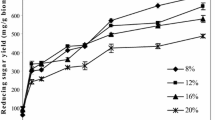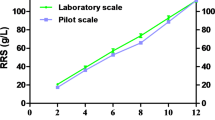Abstract
Cassava starch production waste (cassava pulp) has been proposed as a high potential ethanolic fermentation substrate due to its high residual starch level and the small particle size of the lignocellulosic fibers. Saccharification of the residual starch from a 3% (w/v) dry weight basis (DS) of cassava pulp by α-amylase (100°C, 10 min) and glucoamylase (60°C, 2 h) resulted in a glucose yield of 22.6 g/l [67.8% (w/w) DS of cassava pulp] and in lignocellulosic fibers at 0.5 g/g DS cassava pulp. Pretreatment of the lignocellulosic fiber with dilute sulfuric acid and calcium hydroxide at 121°C, 15 lb/in2 for 30 min increased and decreased, respectively, its susceptibility to cellulase hydrolysis. Under the optimal conditions found, pretreatment of 6% (w/v) DS lignocellulosic fiber by 2% (w/v) H2SO4 for 30 min, followed by saccharification by cellulase (40°C, 9 h), yielded a glucose level of 26.6 g/l [79.8% (w/w) DS of the cassava pulp]. The starch and lignocellulosic fiber hydrolysates obtained from 30 g cassava pulp and 60 g H2SO4 pretreated lignocellulosic fiber were fermented by Saccharomyces cerevisiae, without the need for (NH4)2SO4 supplementation, to yield ethanol levels of 9.9 and 11.9 g/l, respectively, after 48 h.





Similar content being viewed by others

References
Balagopalan C, Ray RC, Sheriff JT, Rajalekshmy L (1994). Biotechnology for the value addition of waste waters and residues from cassava processing industries. In: Proceedings of the second international scientific meeting of the cassava biotechnology network. Bogor, Indonesia, 22–26 August 1994. Working document no. 150, Centro International de Agricultura Tropical (CIAT). Cali, Columbia. 690-701
Gregg D, Saddler JN (1996) A techno-economic assessment of the pretreatment and fractionation steps of a biomass-to-ethanol process. Appl Biochem Biotechnol 57-58(1):711–727
Gupta R, Sharma KK, Kuhad RC (2009) Separate hydrolysis and fermentation (SHF) of Prosopis juliflora, a woody substrate, for the production of cellulosic ethanol by Saccharomyces cerevisiae and Pichia stipitis- NCIM 3498. Bioresour Technol 100:1214–1220
Millati R, Niklasson C, Taherzadeh MJ (2002) Effect of pH, time and temperature of overliming on detoxification of dilute-acid hydrolyzates for fermentation by Saccharomyces cerevisiae. Process Biochem 38:515–522
Office of the National Economic and Social Development Board (2007) Development and promotion guideline for biochemical industry. Research and Consulting Institute. Thammasart University, Thailand
Pettersen RC (1984) The chemical composition of wood (chapter 2). In: Rowell RM (ed) The chemistry of solid wood, Advances in Chemistry Series, vol. 207. American Chemical Society, Washington, DC, p 984
Somogyi M (1952) Notes on sugar determination. J Biol Chem 195:19–23
Srinorakutara T, Kaewvimol L, Saengow L (2006) Approach of cassava waste pretreatments for fuel production in Thailand. J Sci Res Chula Univ 31(1):77–84
Sriroth K, Chollakup R, Chotineeranat S, Piyachomkwan K, Oates CG (2000) Processing of cassava waste for improved biomass utilization. Bioresour Technol 71:63–69
TAPPI (1988) Test method for determination of alpha-beta and gamma-cellulose in pulp. Technical Association of Pulp and Paper Industry, 203 om-88. TAPPI, Atlanta, Georgia
Acknowledgments
The authors thank Dr. Robert Butcher for critical reading of this manuscript. This study was financially supported by the Thai Government Stimulus Package 2 (TKK 2555), under the Project for Establishment of Comprehensive Center for Innovation Food, Health Products and Agriculture, the Ratchadapisek Somphot Endowment Fund (AG 001B) and the Thailand Institute of Scientific and Technological Research (TISTR). We thank two anonymous referees for their helpful comments that improved this manuscript.
Author information
Authors and Affiliations
Corresponding author
Rights and permissions
About this article
Cite this article
Akaracharanya, A., Kesornsit, J., Leepipatpiboon, N. et al. Evaluation of the waste from cassava starch production as a substrate for ethanol fermentation by Saccharomyces cerevisiae . Ann Microbiol 61, 431–436 (2011). https://doi.org/10.1007/s13213-010-0155-8
Received:
Accepted:
Published:
Issue Date:
DOI: https://doi.org/10.1007/s13213-010-0155-8



